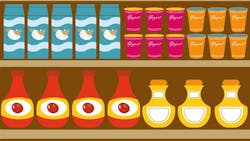Supply Chain & Logistics: Collaboration Provides a Sobering Solution for CPG Industry
Consumer packaged goods (CPG) companies are squeezed at virtually every step along the supply chain, whether from raw-goods suppliers, wholesalers, retailers and in some cases, end users themselves, all with their own specific expectations and demands. Drastic changes in consumer behavior have shrunk product lifecycles to almost ridiculously short periods.
See Also: Lean Supply Chain Logistics Best Practices
For CPG companies to remain competitive, they need to be able to anticipate this rapidly changing market landscape, points out Sean Monahan, a partner with consulting firm A.T. Kearney. Their consumer base, for instance, is one of increased ethnicity and urbanization, with consumers opting for on-the-go convenience, preferably from locally sourced suppliers. "Quality and value," Monahan says, are the new mantra of the marketplace, with private labels and value brands no longer carrying much of a stigma. "Companies need to pursue cost-reduction strategies while offering increased service and variety."
Retailers, the primary customers of CPG companies, are responding to these pressures in one of three ways, Monahan says:
- Localized online model (e.g., Amazon), where the consumer shops online.
- Hybrid model (e.g., Walmart), offering various formats to the consumer, such as online, convenience, traditional in-store, value, depending on need.
- Hyper-value model (e.g., dollar and club stores), appealing to consumers highly sensitive to price.
Those strategies are causing manufacturers and wholesalers to focus more intently on tightening their supply chain relationships with the retailers. With mounting pressure to lower costs wherever possible, Southern Wine & Spirits, a $9 billion distributor, worked with A.T. Kearney to unlock collaborative synergies despite being tied to a federally mandated three-tier system of producers, wholesalers and retailers. Alcohol sales in the U.S. involve the movement of product from 200,000 producers to hundreds of wholesalers to 630,000 retail outlets.
Southern itself represents 1,600 suppliers and serves 179,000 retail customers, explains Phil Morsing, vice president of national operations, supply chain management. The distributor carries 58,000 active SKUs and maintains 32 distribution centers (DCs) across 20 states.
Southern is engaging with a major supplier on a joint project to tighten up supply chain integration. Rather than continuing the practice of independently forecasting sales at the brand and divisional levels, the companies are jointly forecasting across all three tiers: supplier, wholesaler and retailer, with an evolving goal of forecasting at the SKU level and then -- here's the key -- sharing that information.
One such project underway involves Southern's opening a regional DC that would allow suppliers to bypass Southern's DCs in some cases, permitting consolidated volume on fewer transportation lanes. By aggregating the forecasting process, safety-stock requirements can be greatly reduced. Plus, a streamlined bottling operation allows for fewer but larger quantities, and more predictable orders. The end result of these shifts is a more efficient and cost-effective operation for both the supplier and Southern. The regional DC is set to open in spring 2013, Morsing notes.
About the Author
Dave Blanchard
Senior Director of Content
Focus: Supply Chain
Call: (941) 208-4370
Follow on Twitter @SupplyChainDave
During his career Dave Blanchard has led the editorial management of many of Endeavor Business Media's best-known brands, including IndustryWeek, EHS Today, Material Handling & Logistics, Logistics Today, Supply Chain Technology News, and Business Finance. He also serves as senior content director of the annual Safety Leadership Conference. With over 30 years of B2B media experience, Dave literally wrote the book on supply chain management, Supply Chain Management Best Practices (John Wiley & Sons, 2010), which has been translated into several languages and is currently in its second edition. He is a frequent speaker and moderator at major trade shows and conferences, and has won numerous awards for writing and editing. He is a voting member of the jury of the Logistics Hall of Fame, and is a graduate of Northern Illinois University.
